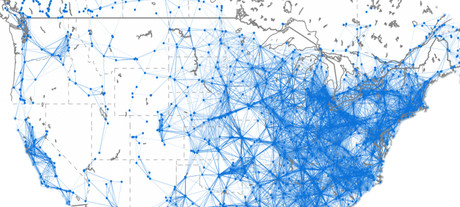US spectrum auction relied on computer science

When mobile phone carriers in the US paid US$19 billion to scoop up spectrum no longer needed by television broadcasters, they used an auction process designed by University of British Columbia (UBC) and Stanford University researchers.
While spectrum auctions are nothing new, this one was so complex and involved so many moving parts that computer science was used to solve the problem. A paper published in the Proceedings of the National Academy of Sciences (PNAS) outlined the complexity of the problem and explained how the economists and computer scientists worked together to design the solution.
Past radio auctions were not limited by the amount of spectrum, and this was the first time that the US Federal Communications Commission (FCC) had asked television stations to auction off their unneeded airwaves directly to mobile providers.
The auction repurposed 84 MHz of spectrum. Broadcasters made US$10 billion and, after covering costs, the government’s US$7 billion earnings were put toward the national debt as was required by legislation.
The success of the auction is the result of a clever reverse auction solution where the price wasn’t set by the highest bidders, but by how low broadcasters were willing to go to turn over their spectrum. This solution was developed and designed by the team of computer scientists and economists.
“Auctions work when we don’t know what things are worth,” said Kevin Leyton-Brown, a UBC computer science professor. “In this case, we were asking television stations to decide how much it was worth for them to stop broadcasting.”
This meant that in densely populated regions, like New York and Los Angeles, broadcasters made more money from their sales. Meanwhile, broadcasters in regions like the Midwest were paid less for their spectrum.
“The auction paid billions of dollars to television stations to stop being broadcasters, which is good for struggling stations that had no other way to sell broadcast rights,” said Leyton-Brown. “People will be happier with faster phones and the government achieved its goal to make better use of the spectrum, which strengthens the economy and widens the tax base.”
Remarkably the system also factored in a number of other considerations at the same time, such as the number of trades happening at once and property rights. For example, some broadcasters were willing to sell channels in a number of different places around the US, provided certain conditions were met in each of those different regions.
The auction system may come in useful as countries prepare to sell bandwidth for the future 5G mobile network. Leyton-Brown says the design could also be used as a template for similar auctions on a much smaller and simpler scale. For example, some conservation groups will pay farmers along migration routes to delay harvesting their crops to give birds a place to stop.
The auction is also an example of how computer science and artificial intelligence are now necessary to handle the day-to-day processes and demands of our world. In the past, with less complex products to sell, governments and economists could have made an auction work on their own.
“When economic designs get complicated enough, it becomes a computer science problem,” said Leyton-Brown. “This is a relatively new phenomenon.”
Image caption: A visualisation of the incentive auction’s 2.7 million pairwise interference constraints. Image credit: Kevin Leyton-Brown, Paul Milgromb and Ilya Segalb.
The new wildfire reality: mapping a response
Firefighter-turned-researcher Chris Dunn is helping pioneer data-driven solutions to tackle...
ARCIA update: LMR is not dead yet
Be it mining, rail, public safety, transport or utilities, everyone is embracing new technology...
Towards 1 Tbps throughput using sub-terahertz bands
In order to enable the near-instantaneous communication promised by 6G, ultrahigh data speeds...






